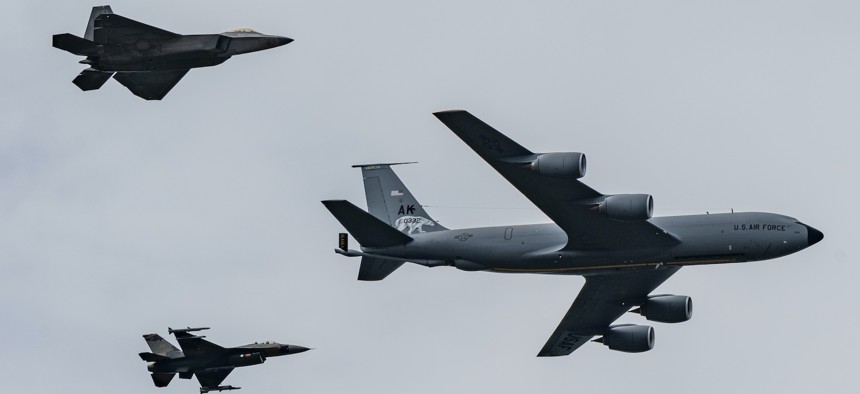
In this 2021 photo, several types of U.S. Air Force aircraft fly in formation during an air show in Alaska. U.S. Air Force / Capt. Kip Sumner
Anduril, General Atomics win more USAF money to develop robot wingmen
But the giants they beat out are welcome to pitch self-developed drones for production contracts.
Anduril and General Atomics have beat out three defense giants to develop the first slew of Air Force drones that will escort fighter pilots into combat.
Anduril and General Atomics will handle “detailed designs, manufacture, and testing of production representative test articles” under the program, known as collaborative combat aircraft, the Air Force announced today.
The pair will develop CCAs in “increment one” of the program, which is focused on fielding drones quickly. Drones in the next tranche, “increment two,” will be fielded later and likely feature different capabilities.
The Air Force had hoped to fund further development by three of the five vendors in the pool, which also included Boeing, Lockheed Martin, and Northrop Grumman. The choice of two suggests that the service lacked the money.
But any of the five companies may compete for the increment one or two production contracts; they’ll just have to spend their own money to further develop their design.
“The companies not selected to build these production-representative CCA vehicles, and execute the flight test program, will continue to be part of the broader industry partner vendor pool consisting of more than 20 companies to compete for future efforts, including future production contracts,” the service said.
The Air Force has not said if it will carry more than one company into production, but that it will make a “competitive production decision” for increment one in fiscal 2026 and field a “fully operational capability” before the end of the decade, according to today’s statement.
And for increment two—the service will start “initial activities” later this year, then award contracts in fiscal 2025 to conduct preliminary design work, Kendall has said.
“Just over two years ago, we announced our intent, as part of our operational imperatives, to pursue collaborative combat aircraft. Now, following the enactment of the fiscal year 2024 budget, we're exercising option awards to two companies to construct production representative test articles. The progress we've made is a testament to the invaluable collaboration with industry, whose investment alongside the Air Force has propelled this initiative forward. It's truly encouraging to witness the rapid execution of this program,” Kendall said in today’s statement.
The service wants to buy at least 1,000 CCAs to fly alongside F-35s and the future Next Generation Air Dominance, or NGAD, aircraft. The NGAD program is envisioned as a “family of systems” with crewed and uncrewed platforms.
